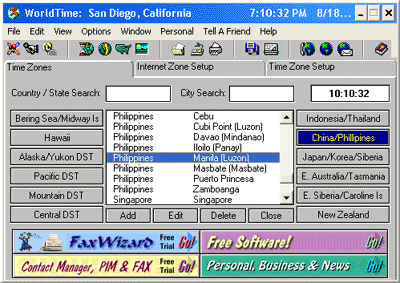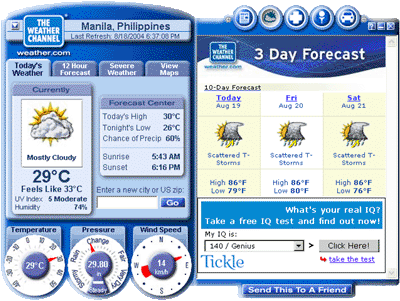Softwares for Accurate Time and Weather
How is time measured? For many years one second was defined as 1/86,400 of the mean solar day, thus eliminating seasonal variations. So this was based on the movement of the sun, but we all know that it is actually the movement of the earth. And we were assuming the earth moves at a very precise constant rate, which it does not. And the earths rotation is not really 24 hours. It is 23 hours, 56 minutes and 4.09 seconds, that's why the leap year exist.
So given this problem, in 1956 ephemeris time (ET) was used, which is calculated from the motions of celestial bodies in accordance with the laws of motion. 1 sec is 1/31,556,925.9747 of the length of the tropical year for 1900. I can't even imagine how this is done just by looking at the stars around us. But I could imagine a lot of trigonometry and calculus is involved using telescopes in various locations and heights focusing on a single object in space and comparing the angles of the telescopes taking note of the location in three dimensional space of each telescope.
I guess this was too hard to measure that's why in 1967 the second was redefined to be 9,192,631,770 periods of vibration of the radiation emitted at a specific wavelength by an atom of cesium-133. So it this the most accurate? Actually not. Electromagnetic waves could still influence very, very small fractions of the periods of vibration in an atom. Although this is very, very small fractions of a second, as years pass by this will have a great effect.
In Greenwich, London, the Royal Observatory in Greenwich has been transmitting time and called it the GMT standard or Greenwich Mean Time which was used initially to standardize time at train stations throughout Europe. Their time was based on the celestial bodies. Since this was not accurate and the Atomic Clocks were invented, the UTC scale came out of the Coordinated Universal Time. Coordinated since as I explained above the problem with the cesium atom, there are several Atomic Clocks and each one coordinates with each other. I do not know what type of statistics they use, but I assume it is the simple average.
Now one nice thing about the Internet today is that there are Time Servers all over the world that gets updates from these Atomic Clocks, and clocks all over the world could update time from the time servers.
Well let's finish the introduction about time since you might be getting bored already. I used to use a software named Atomic Clock which was recommended by Louie Morales by the way. Then I switched to ClockG2 since it has a world time function. Now I am using WorldTime2000 by MultiSource. But I did not download mine from MultiSource. I got mine from download.com, you could go straight to the link by clicking here. I have had problems with the one downloaded from MultiSource, I do not know why, so I suggest get the one at Download.com too.

Now whenever I am connected to the Internet, I could update my PC clock connecting to the time servers and look at the time at any city around the world. Very useful for me since I am running my business in the Philippines while I am currently in San Diego, California. Now aside from that I could also see the weather at nearly any city around the world. This is powered by Weather.com and they have a software called Desktop Weather. You could download the software here.

Desktop Weather gives you temperature, humidity, UV index, wind speed and direction, atmospheric pressure, temperature highs and lows, sunrise and sunset time and a 12-hour forecast as well as a 3-day forecast. It also has coming storm warnings. So if you like to know what the time and weather is anywhere around the world, I recommend these two softwares.
0 Comments:
Post a Comment
<< Home